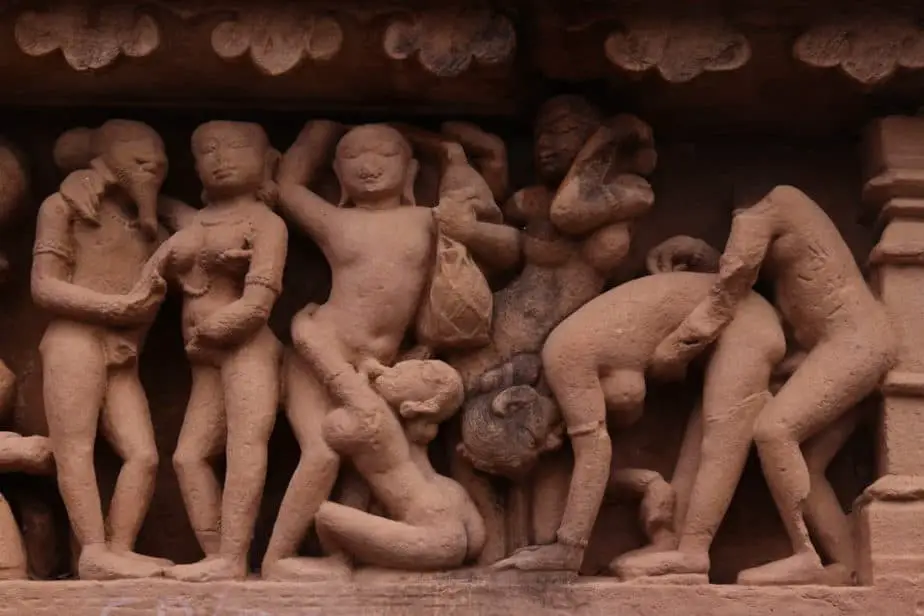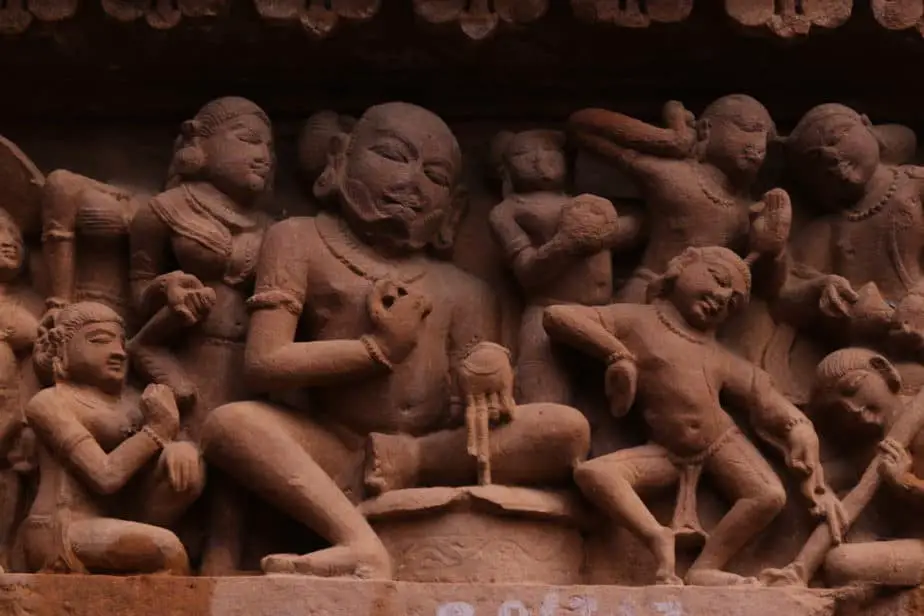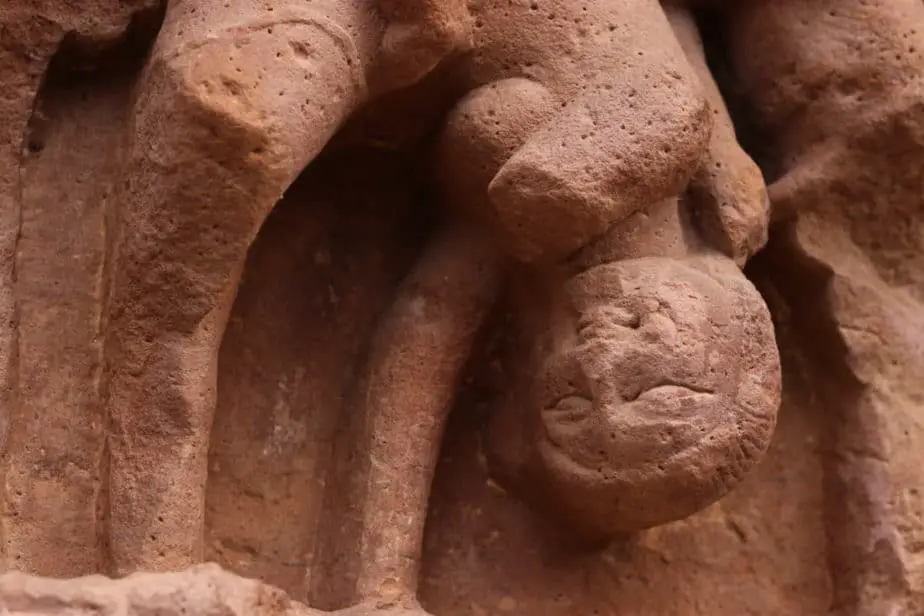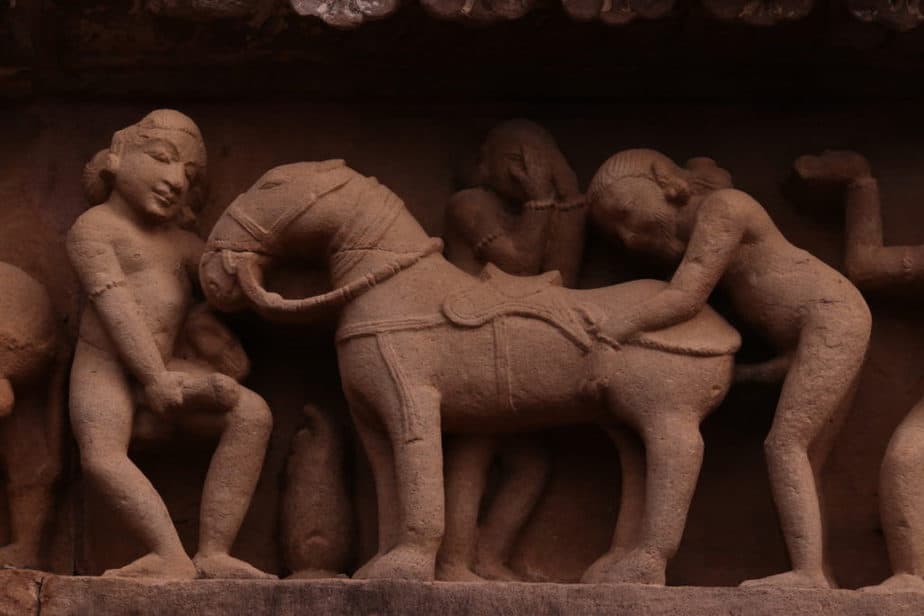
Khajuraho is best known for the 1,000-year-old temples that depict the kama sutra. For tourists who want to see some of India’s most unique and well-preserved temples, as well as explore a quieter destination… this is a great place to visit.
How much time is required to visit Khajuraho? You can see the 25 temples in 6 hours. Since Khajuraho is 8 to 10 hours from cities like Agra and Varanasi it’s worth spending 2 nights here. You can also learn more at the State Museum of Tribal and Folk Art, shop for cloth and souvenirs, and see the Light & Sound show at night.
A complete itinerary for Khajuraho is:
- Western Monuments: The most impressive temples are here.
- State Museum of Tribal and Folk Art: You can learn more about the art and people of the area.
- Eastern Monuments: In a nearby village you can see beautiful Jain temples.
- Southern Monuments: There are a couple other temples near the airport.
- Light & Sound Show at Khajuraho Temple: At night you can learn more about the temples and see them lit up with colorful lights.
- Shopping in local markets
For day trips near Khajuraho, you could see:
- Panna National Park: It’s a tiger reserve with plenty of local wildlife.
- Pandev Waterfall: This 98-foot (35-meters) waterfall is beautiful.
- Raneh Falls: It’s been named the Grand Canyon of India.
- Ajaigarh Fort: See the home of the local kings.
- Ayur Arogyam: Get a relaxing Ayurvedic massage.
I had a great time here and it was a welcome rest from the crazy busy-ness of Agra. There is some very cool things to see and I wish I had better information, which is why I’m writing this post to point you to the best things to see in Khajuraho.
If you prefer a free cheatsheet, check it out and download here.
Disclaimer: The post contains photos of erotic scupltures and is only for mature audiences.

Where is Khajuraho Located?

Khajuraho is located in Madhya Pradesh and Pradesh means “state” but Madhya means “central.” Central means heart, so Madhya Pradesh is the heart of India, and Khajuraho is the heart of Madhya Pradesh, so it is the heart of India.
I recommend taking a train here from Agra which is 8 hours and costs less than $20. You can get an overnight sleeper train and arrive in the morning with a decent sleep.
What Is the Story Behind the Temples?

Khajuraho comes from the words, Khajur which means “date palm tree,” and rah means “street or path,” so Khajuraho is named after the trees here where there was once a street to the village. Khajur also means scorpion in Sanskrit, which symbolizes passion and hunger. The walls of Khajuraho depict the passion and hunger of love. The area was settled 10,000 to 15,000 years ago, according to the paintings in the caves.

Who built the Khajuraho Temples? The temples were built by the Chandela empire which ruled the area from the 9th to the 13th centuries. They were at the height of their power from 950 to 1050. In the legend, the founder of the Chandela was the son of the moon god and are the descendants of Soma. In Sanskrit, Soma means moon.
Khajuraho was the capital city of their empire for a time, because it was the center of their territory and protected by rivers, mountains and jungles from invaders. This is one reason these temples were so well-preserved.
The Chandelas built 85 temples during their reign but they weren’t all built at one time. As each ruler took power, they would build another temple or two.

How were the temples at Khajuraho built? They were built by 16,000 artists from sandstone at a quarry 40 kilometers away. To prevent carrying excess rock, the artists would carve them at the quarry and then the sculptures would be hauled to Khajuraho.
In the 13th century, the Muslims invaded the area and the Chandelas lost all their money and power. The invaders destroyed many of the temples and the others were forgotten in the jungle.
Eventually the trees in this region grew taller than the temples.
How Were the Khajuraho Temples Rediscovered?

In 1838, the British engineer T.S. Burt was surveying the area and heard from the locals there were “houses of God” in the jungles. After corresponding with the British government, they started to rebuild the temples with bricks and limestone.
In 1986, UNESCO declared it a world heritage site, so these sites will be with us for a while.
Why Are the Khajuraho Temples Famous?

The temples in Khajuraho are well-known because of the erotic sculptures however the sculptors also did a few other unique things:
- The facial expressions are detailed
- The architectural point of view was unique
- The sculpture point of view was different
- The women depicted have a high social status

Less than 5% of the sculptures here are erotic, 95% depict what is happening in the society at that time such as:
- Soldiers fighting battles.
- Elephants crushing traitors’ heads.
- Devotees learning from spiritual teachers.
- Women picking thorns from their feet.
- Dancers.
- Women applying makeup.
- Musicians playing music.
- Farmers tending their fields.

Why is spirituality and sexuality depicted in the temples? At this time in Indian culture, sexuality was seen as one way to find enlightenment. In the Vedas, there are two ways to become enlightened:
- Through denying the senses: Meditating in a cave away from the world.
- Through embracing the senses: The pleasures of sexuality through techniques from the Kama Sutra.

Sexuality was not taboo at this time. Hindus believed sexuality was a part of life and that husbands and wives could help their partner achieve a happy life through sexual pleasure. Christianity and Islam did have taboos against sexuality and it wasn’t until these religions were introduced that these concepts became more widely known in Hinduism.
Western Group of Monuments

Close to the center of the town of Khajuraho is the western group of monuments. These are the main attractions here and are worth spending at least a few hours at.
I first explored them with a guide, who shared the history of the temples and pointed out the most interesting sculptures. The next morning I went back by myself to photograph my favorite parts.
Tickets are 600 Rs for foreigners and 40 Rs for Indians.
There are 5 big temples on these grounds and 12 temples total.

The first big temple is the Vishwanath Temple. It was built between 930 and 950 AD. It is devoted to the God Vishnu and it took 16,000 artists to complete the temple over 20 years. This temple is unique for its depiction of facial expressions.
- You can see mothers giving her child to be a servant with a sad face.
- The mother receiving her child with a happy face.
- Women picking thorns from their feet with pain on their faces.
- Women stretching in the morning with pleasure.
- There is an elephant laughing as it watches a couple copulating.
You can see the wife of Shiva, Parvati in the incarnation of Chamunda drinking the blood of a demon because if the blood were to spill then each drop would make a new demon.
There is a pig, the third incarnation of Vishnu near the entrance with 674 gods carved on its sides.

The second large temple is Kandariya Mahadev at the back of the grounds. It was made 100 years after the Vishwanath Temple and has taller, thinner sculptures. You can see some perverse acts in the sculptures like bestiality, and you can see people turning away from acts suggesting that it was not approved by society. However, these are not the focus of the temple and you need to look closely to see where they are located.

Devi Jagadambi Temple
This temple is similar in structure to the Kandariya Mahadev temple but smaller. Because it isn’t as tall as the other temples, you can see some of the sculptures better.

Vamana Temple
This temple is honoring Vamana, an incarnation of god Vishnu.

Lakshman Temple
One of the largest temples in the group of monuments and was built in 954 AD. It is honoring Visnu. It is named after Laxman the younger brother of Rama in the Hindu epic the Ramayana.

Devi Mandap
This small shrine is near the Lakshman Temple and has a roof indicating it was rebuilt in the last century.

Varaha Mandar
Just to the south of the Devi Mandap, there are 14 small pillars and a pyramid-shaped roof.

Mahadev Shrine
This is a small shrine with a lion in a battle with a kneeling person. The lion is the icon of the Chandelas.
State Museum of Tribal and Folk Art

Just to the north of the Western Group of Monuments, continue past them on the road, take a left, and then it’s on the right.
You can see ancient tribal arts and crafts and get more of a sense of the people here.
Light & Sound Show

As the sun sets you can watch the temples lit up with colored lights as a narrator shares more information about these structures. There is an English language show and a Hindi show. The show runs 7 days a week, unless there is rainy or stormy weather.
| Months | English Show | Hindi Show |
| Winter: October through February | 18:30 – 19:25 | 19:40 – 20:35 |
| Summer: March to September | 19:30 – 20:25 | 20:40 – 21:35 |
The prices are 700 Rs for international tourists and 250 Rs for Indian tourists. You can see the website for more details.
The show is a wonderful end to a day before enjoying some delicious dinner.
Eastern Group of Monuments

You can hire a bike, taxi or auto-rickshaw to visit these monuments which are a mile or so away. These monuments are in a small village on the outskirts of Khajuraho. There is no admission fee for these monuments and it’s very peaceful here.
There are a few Jain temples in a small complex.
Parsvanath temple
This temple is honoring the 23rd Tirthankara Parshvanatha (there were 24 “lord makers” of the dharma of Jain). It is thought to have been built around 930 to 950 AD.
Adinatha Temple
This temple is honoring Tirthankara Adinatha who was the first Tirthankara of Jainism. It was built in 1075 AD. The sculpture of Adinatha is made of black stones.
Ghantai temple
This temple is the only one with a wall protecting it and has sculptures of bells (in Hindi ghanta means “bells) on the pillars.
Javari Temple
This temple was built between 1075 to 1100 AD. This is honoring Lord Vishnu in the Nirandhar architectural style.
Vamana Temple
Vamana is the fifth incarnation of Lord Vishnu and was built in 1050 to 1075 AD.
Hanuman Temple
This temple is right near the village part of Khajuraho and was built in 922 AD.
Brahma Temple
This temple is honoring Lord Vishnu and is one of the few Hindu temples in the Eastern Group. This temple was one of the only temples in the area made from granite. They moved to sandstone because it was much easier to carve. It was built in 925 AD.
Southern Group of Monuments

The temples here are not as impressive as in the other parts of town, however there are a couple of temples near the airport which are worth seeing.
Chaturbhuj Temple
This is a temple honoring Lord Vishnu with a nice scultpure inside. It’s not as tall as the Western temples.
Dulhadeo Temple
If you’re looking for love, this might be the temple for you. Dulha means “bridegroom” and there are 11,000 Shiva lingas helping devotees find their soulmate.
Shopping in Khajuraho

Unlike the popular markets in Delhi or Mumbai, there are far fewer tourists here which might mean you can get some great prices.
They have saris, handloom and textiles, small stone sculptures of the temples, silver and brass sculptures, jewelry and more.
My mom and aunt spent half of a day sipping tea and checking out the deals, before coming home with a bag of souvenirs for our family.
Day Trips from Khajuraho
Panna National Park
Almost 100 kilometers away you can see one of the state’s tiger reserves as well as jungle cats, rusted spotted cats, wild dogs, leopards, hyenas, the sambar, and many more.
Price: 2000 Rs for foreigners. 1000 Rs for Indians
Raneh Falls
This is a little-known spot 23 kilometers to the east of Khajuraho. Some call it the Grand Canyon of India and it’s pretty impressive on the Ken River. Check out the range of indigenous rocks from black basalt, brown quartz, green dolomite, red Jasper, and pink granite.
Not far from the falls is a sanctuary for water crocodiles called Gharials and if you are lucky you might see one.
Pandev Waterfall
Near the Raneh Falls in the Panna National Park just 35 kilometers from Khajuraho, you can see a beautiful 98-foot (30-meter) high waterfall.
There are hardly any tourists here and if you want to get away from the crowds of India and meditate this is a great place.
Ajaigarh Fort
Just 61 kilometers from Khajuraho you can see the once majestic and now crumbling home of the Chandela kings. Unlike popular forts such as the Amber Fort or Agra Fort, there is no entry fee here.
At a height of 2257 feet (688 meters) set in the Vindhya mountains, it’s recommended you hire a guide to show you the fort as the climb up is quite steep.
Ayur Arogyam
If you had a long day, in the town of Khajuraho there is a relaxing massage awaiting you at the Ayurvedic center. You might also find a yoga class or some healthy supplements.
When To Visit Khajuraho?
Most people visit during the winter months from November to February.
Khajuraho Dance Festival
In the last week of February, people flock to Khajuraho to see beautiful classical dances like Bharatanatyam, Kathak, Kuchipudi, Kathakali, and Odissi.
The dances happen with the imposing temples behind such as the Chitragupta Temple and the Vishvanatha Temple which are both in the Western Group of Monuments.
Check their website for up-to-date info about the next festival.


